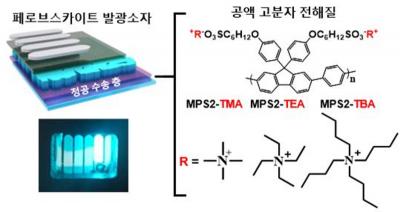A team of researchers at the Ulsan Institute of Science and Technology (UNIST) and Korea University, led by Professors Myung-Hoon Song, Sang-Gyu Kwak and Han-Young Woo, recently announced the development of a PeLED - a perovskite-based LED device, that emits blue light.

The team explained that the perovskite light emitting device, which uses perovskite as a color material, is more than three times more efficient than before and has a high color purity, enabling a clear blue color.
However, the blue PeLED consumes a lot of power as the efficiency of converting electrical energy into light is only 10%. In fact, it is less than half of that of red or green. An additional problem is that the color purity decreases over time due to the ions added to implement the blue PeLED.
Therefore, the researchers used a novel method to improve the performance of the device by changing adjacent materials rather than complex manipulation of the Perovskite material. In the light-emitting device, the material used as a hole transport layer adjacent to the perovskite was changed.
When the newly synthesized organic material was used as the hole transport layer, the efficiency improved by 3 to 4 times compared to the existing light emitting device, and the 'electroluminescence spectrum', an index indicating color purity, was greatly stabilized, the research team said.
Researcher Choong-Hyun Jang, the first author, commented: 'This study solved the fundamental problem of blue PeLED by changing the properties of the interface between the perovskite and the hole transport layer (interface between different materials), not the perovskite emission layer itself. It is significant".
The team also used a conjugated polymer electrolyte as a hole transport layer in place of the conductive polymer (PEDOT:PSS) used in PeLED devices. When the hole transport layer is changed to this material, the regularity (crystallinity) of the perovskite structure is improved and defects are reduced at the interface, greatly improving the efficiency of the light emitting device converting electricity into light.
In addition, as the size of the side branch ions constituting the conjugated polymer electrolyte increased, the perovskite material had clear crystallinity and fewer defects at the interface. Regarding this, Prof. Song Myung-hoon said, 'PeLED achieved the efficiency of OLED (Organic LED) level for a short period of 6 years, but the blue light efficiency was at the level of 10%." It will be able to accelerate commercialization.'
Professor Song also developed a flexible PeLED that can be folded last year with Professor Joo-Young Kim. UNIST said about the research at the time, "This device uses a perovskite material as an active layer that emits light by receiving electricity. It has advantages such as high electron mobility, but PeLED has low flexibility and opacity due to the limitation of metal electrodes".